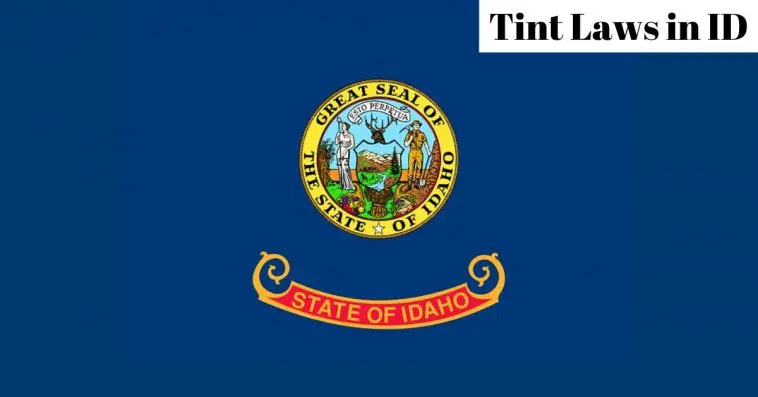While you are generally allowed to apply a tinting film to your windows, it is important to realize there are certain restrictions applied to the darkness of the tint. Failure to comply with regulations can result in a fine.
It is considered illegal to have windows tinted to a darkness that is past the stipulated level. Each state has its own laws related to tinting, and a fine can be issued if your windows are too dark in Idaho.
This post takes a closer look at the window tinting laws that you need to follow in Idaho. I also consider whether it is legal to have a reflective coat on your windows and look at the penalties due when you do not comply with these regulations.
TABLE OF CONTENTS
Are You Allowed To Have Tinted Windshield And Windows In Idaho?
Idaho has relatively lenient laws surrounding the tinting of windows on vehicles. You should still ensure you understand the regulations and comply with the window tinting laws.
Idaho implemented laws surrounding window tinting in 1992. The focus of these laws is to reduce accidents and other problems caused by tinted windows that do not allow enough light to pass through.
What Is The Darkest Tint You Can Legally Get In ID?
The maximum darkness allowed on tinted vehicle windows is 80%. This guideline only applies to the backside windows in the vehicle. The same regulation applies to passenger cars and multi-purpose vehicles.
Other windows in the car should allow more light to pass through. The rear window may not block more than 65% of light transmission. This regulation applies to the front side windows in the vehicle too.
The windscreen may not be tinted, apart from a small six-inch line at the top region.
Is 20 Tint Illegal In ID?
It depends on the window that is being tinted. A 20 tint may be applied only to the side windows that are located at the rear side of the car. No other window in the vehicle is allowed to have a 20 tint.
When applying a 20 tint to other windows in the car, your vision of the road ahead and vehicles in the surrounding area may be reduced at a significant level – increasing the risk of a vehicle accident.
Can You Get Pulled Over For Tinted Windows In Idaho?
While a tint that is too dark is not considered a criminal offense in Idaho, it is still illegal. Thus, cops and police can pull you over if they find that the tinting on your windows seems too dark.
In this case, a device will be used to detect the amount of light allowed to pass through your tinted windows. The penalty for non-compliance with the window tinting laws is a traffic infraction.
How Much Is A Tint Ticket In ID?
When your window tint darkness or reflection does not comply with the regulations set out by Idaho laws, then you are due for a ticket. The ticket will usually be $67.
Window Tint Darkness In Idaho
Idaho regulates the darkness levels that may be applied to vehicle windows throughout the state.
The darkness is measured by a small device that cops usually carry with them. The reading is provided in VLT, which refers to the amount of visible light transmittable through the tinting.
For Passenger Vehicle
- Windshield: A maximum of six inches may be tinted at the top with no reflective coatings.
- Front Side Windows: At least 35% of light should be allowed to pass through.
- Backside Windows: 20% or more light need to pass through the windows.
- Rear Window: 35% or more light should be allowed to transmit through the tinted window.
For MPV (Multi-Purpose Vehicle)
- Windshield: A six-inch line may be tinted at the top of the window. No reflections may be present.
- Front Side Windows: A minimum of 35% light should pass through the tint film.
- Backside Windows: No more than 80% of light may be blocked out.
- Rear Window: 35% of light should pass through.
Window Tint Reflection In Idaho
Tinted films are often accompanied by some level of reflection, depending on the type of tinting you apply to your windows. There are specific laws in Idaho that regulate the amount of reflection allowed on your windows.
For Passenger Vehicle
- Front Side Windows: Maximum reflection rating of 35%.
- Backside Windows: Maximum reflection rating of 35%.
For MPV (Multi-Purpose Vehicle)
- Front Side Windows: Reflection must be lower than 35%.
- Backside Windows: Reflection must be lower than 35%.
How Do You Get A Medical Exemption For Window Tint In Idaho?
There are special cases where some people are allowed to obtain a tint on their windows that is darker than what the law allows. This applies to patients with certain conditions, such as an illness that causes extreme sensitivity to light.
Should you have a diagnosis with a qualifying illness, you will need to obtain a signed document from your doctor. The letter should be issued by a physician that is licensed to practice in Idaho.
There are specific guidelines that regulate the amount of tint allowed when a medical exemption has been issued. The windshield should allow more than 75% of light to transmit through the film.
All other windows in the car may be tinted to a level that blocks up to 80% of light transmission. The medical exemption document should always be present in your car, as it needs to be presented to the cops should you be pulled over.
Conclusion
It is legal to have a tinted film applied to windows in your car when you live in Idaho. The window tinting laws of Idaho are also relatively lenient when it comes to reflective surfaces.
You do, however, need to ensure you comply with the restrictions that are in place for tinting and reflective coatings.
If you are pulled over with tinting that is too dark, a fine will be issued. You will also be requested to fix the tinting to ensure more light can transmit through the film.




